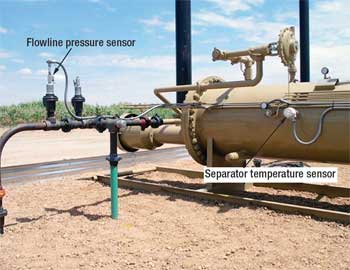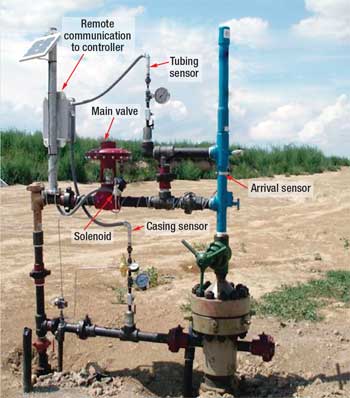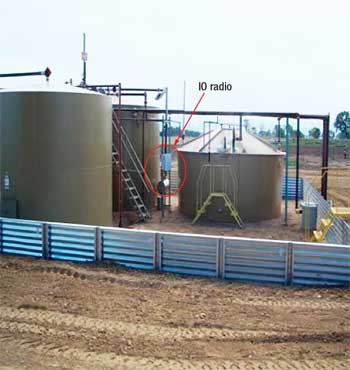Remote monitoring and control assist plunger lift
The use of remote electronics to monitor a few key data points allows operators to maximize production and prevent damage to plunger lift wells.Jim Gardner, FreeWave Technologies, Inc. Plunger lift is a form of artificial lift used by natural gas producers who experience heavy downhole fluid loads. In many cases, when a gas well produces excessive fluid volumes, the gas pressure of the well is unable to overcome the weight of the fluid trapped inside the tubing. That prevents the well from producing the gas because, essentially, it is blocked by the fluids. When a well has been blocked by fluids, the common practice has been to manually shut in the well, thus creating downhole pressure. The objective is to build enough downhole pressure to lift the gas. To improve this process, producers use a plunger to assist with lifting the fluid. Incorporating the plunger is quite effective, but not without its own risks. If the plunger is used incorrectly—such as allowing excessive plunger travel speed—damage is likely to occur to at least the plunger equipment and maybe to other valuable assets. The manual plunger process also requires management by an experienced operator for optimal results. Technologies that combine plunger control and remote monitoring can free technicians to do other tasks while minimizing the risk of damage to equipment or production and maximizing productivity. MANUAL VS. AUTOMATED CONTROL By remotely monitoring a few critical data points, such as pressure, time, production volume and line pressure, an operator can achieve maximum results at minimal cost and minimal risk of damage, Fig. 1.
Two such data points are tubing and casing pressure. Understanding these pressures and how they correlate with one another allows an operator to determine fluid load, which determines when to resume production. Producing the well too quickly can potentially damage equipment while minimizing flow time, causing reduced daily revenues. Traditionally, this process has been managed manually. In some cases, operators would have to physically be deployed to monitor systems on a well location. The operators would simultaneously monitor plunger arrival times and production volumes, in order to understand the well’s dynamic production characteristics. With this information, the operator developed a time-based program using a mechanical timer that would shut in the well to allow it to accumulate enough downhole pressure to subsequently produce the gas. The timer, of course, would only be time-dependent, and not reactive to any changes that might occur as the well characteristics changed. The problem with this approach is that wells change with time and use. A more attractive alternative would be a “self-optimizing” plunger application, such as a field-based wellsite computer that can monitor flowrates and adjust the time cycle to increase production as the well characteristics change. Automation electronics manufacturers have focused substantial development efforts on the plunger lift control application during recent years, to support customers’ need to improve the time-based shut-in procedures and for remote operation. Manufacturers have created a series of algorithms that allow their electronics to self-optimize the plunger lift process. In other words, the controller, or Electronic FlowMeter (EFM), learns and adapts to changes in well pressure. The algorithms use a collection of data points that include plunger arrival times (time), fluid load (tubing and casing pressure) and flow (volume and time) to make decisions. Based on these data points, along with high and low thresholds set by an operator, the Remote Terminal Unit (RTU), Programmable Logic Controller (PLC) or EFM can automatically self-adjust and determine when to produce (open the production valve) and when to shut in (close the production valve) and, therefore, optimize the overall process for lifting heavy fluid loads. One must consider the up-front costs as well as the estimated lifetimes of various equipment. The cost of a plunger lift control automation package (installed) can run from $3,500 to $12,000. Whether this is a lot or a little will depend on many factors. However, in many cases the system is relatively easy to justify by calculating the rapid return on investment. Many documented cases from differing wells in different geographic areas suggest that a 12–35% increase in production is attainable as a result of implementing automated plunger lift control systems on wells that produce high volumes of fluid. Throw in the savings in ongoing labor and equipment deployment by operating the plunger lift control remotely, and the case becomes even stronger. Some smaller companies may not calculate as sunk costs the staff resources necessary to attempt manual production optimization, because the labor and equipment (e.g., trucks) are required anyway. However, in large systems, when opportunity costs for not deploying those resources for more productive purposes are considered for hundreds or even thousands of wells, the costs of manual optimization can be substantial. Therefore, many operators are switching to new automated plunger systems. Monitoring and control functionality can be accomplished by hardwiring the instruments at the wellhead back to a control box, typically an EFM, or by deploying a new wireless radio technology know as “wireless IO,” Fig. 2. Several radio and instrumentation manufacturers offer wireless IO at differing levels of functionality, RF reliability, price and many other variables.
WIRELESS IO Wireless IO is a mechanism by which analogs (inputs of 1–5 V or 4–20 mA) such as temperature and pressure and discrete inputs (digital signals) such as valve control, high-tank-level alarms, pulse counting and other raw signals may be transmitted via radio to or from a central processing device (EFM, RTU, PLC) from the sensor. Specifically, on a plunger lift well the data transmitted includes level, flow, pressure, temperature, plunger arrival time, alarms and signals generated to facilitate control of devices such as valves. There are several compelling reasons to use a wireless system, chief among them expense. Other factors are:
Wireless systems save even more time and money on “pad” wells that use directional drilling techniques. These installations host multiple wells on one pad, reducing the overall footprint of the wells. These new production techniques and facilities designs also lend themselves easily to automated plunger and wireless control systems, Fig. 3. On the wireless control systems, instead of installing an RTU, EFM or PLC device at each wellhead, a single device can be used per pad. These devices can collect custody transfer information from and conduct plunger lift applications on multiple wells. Some manufacturers’ equipment can support as many as 20 wells with custody transfer gas measurement, plunger optimization and valve control to each of the wells with one EFM.
At the wellhead, the operators use a stand-alone radio to read and transmit the casing pressure and tubing pressure, determine the plunger status and control the valve. The radio does not provide any logic or decision-making capability; it merely replaces a wire between the wellhead and the EFM, where the mathematical algorithms are calculated to determine what needs to be done to optimize the production. Different radio manufactures have different data update rates, but updates as often as 6 times per second are not uncommon. Case studies have found savings of $3,000–$5,000 per wellhead to install a radio instead of an EFM. On a directional drilling pad well with 15 units, those savings could be $42,000 per pad based on a savings of $3,000 per unit. (One EFM unit still is required.) By using one EFM per pad and switching to wireless IO at the wellhead, one major production company in Colorado’s Denver Julesburg Basin claims it saved $4,000 per well. This producer plans to automate 3,500 wells over the next four years in the area around Greeley, Colorado. That’s the equivalent of saving $4 million for every 1,000 wells they automate just in installation costs. CHOOSING A SYSTEM In many areas, pad wells are rapidly becoming the norm. Major producers in Colorado, Montana, Utah, New Mexico and Wyoming are standardizing wireless automation of their wellheads. Many operators are including the use of tank monitoring, flowrates, water meter monitoring, sump or pit monitoring and flare monitors as well as chemical injection monitoring. There is a lengthy list of data points that can be collected wirelessly. Many of the new wireless radios have Modbus capability, so they can theoretically send thousands of data points back to the EFM or controller. Many manufacturers are now offering expandable “IO radios.” These products come with a base set of inputs and outputs, and some offer the user the option of easily adding modules for an expanded IO count where needed. This family of products also offers operators the ability to extend the distance they can send signals from remote equipment to a central point. For example, if an operator has a compressor site a few miles from a well pad, he can use wireless IO to monitor the oil pressure, temperature and on/off status of the compressor. The radio also can transport near-instantaneous signals to provide real-time alarms back into the production office. One of the advantages of using the Modbus version of wireless IO is that these radios are configurable to handle as many IO points as required or as few as are necessary. Every pad or wellsite can have different IO counts. Several Texas operators are monitoring as many as five analog inputs (casing pressure, tubing pressure, flow, etc.) and six digital inputs (plunger arrival, multiple chemical tanks, etc.) on each wellhead. Every producer seems to have found what they consider the “perfect” IO count. Many wireless IO radios are now capable of transmitting data over 30 mi. with good line-of-sight communication paths. Some offer range up to 60 mi. with clear line of sight and perfect conditions. Another important criterion in selecting a wireless IO device is the presence of a “failsafe” configuration, which puts the well into a predetermined configuration in the event of a communication loss. Many wireless IO devices plan ahead for loss of signal. No device is immune to a loss of signal (not even wire). For example, if a wireless IO device that is being used to monitor tank levels loses a signal to the host (RTU), the user should be able to choose what the failsafe condition will be. You can choose to have the inlet valve close on loss of signal, thus preventing the possibility of overflowing a tank. Alternatively, you may choose to “go to open” on loss of signal, if the well doesn’t produce enough liquids to worry about spills, or do nothing until communication is restored. Another important feature is a user-selectable time delay in the radio for loss of signal, i.e., the ability to select how long the radio will wait before taking any pre-selected action. Should the radio change the valve status instantly on signal loss, or should it wait 5 min. before taking action? Some manufacturers also provide a digital output from the radio to the EFM and create an alarm for loss of signal that can call or page the operator for notification of the loss. CONCLUSION Twenty years ago “chart recorders,” manual tank measurement with tape measures, and hand-set timer clocks were the normal tools of the trade for oil and gas production operations. In 2008, nearly 100,000 new wells in the US and Canada were automated with electronic controls. The pace of change has increased every year, with electronics having overtaken manual devices by a 10-to-1 margin last year. The advent and maturation of powerful field computers and wireless technology is changing the production side of the business. These techniques are being used in the Barnett Shale, Marquis Shale, Fayetteville Shale, Bakkan, Piceance Creek and Wattenberg production areas. The following are a few suggestions to help operators select the remote monitoring equipment: Always test and verify. New product claims sometimes have been exaggerated; a two-part evaluation of new equipment is prudent. First, ask the companies’ representatives to bench test the equipment in your facility. They should be able to validate that it will operate as advertised on the bench in your facilities. Second, ask for a field test. One of the important differentiating factors between wireless devices is how well they work in the real world. The factors to consider in real world tests are:
Do research and product validation. It will make a huge difference in your experience. Taking time to talk to other industry “experts” such as your EFM manufacturer or local service provider, to see what their experiences have been with various products, may save you time in narrowing down to a small group of products you want to test. Ask about the service history of the product and the provider. If you have several wells you want to try going wireless on, ask those manufacturers on your “short list” to provide you with a pilot installation to allow you to compare “apples to apples.” Do not consider any manufacturer who is not willing to do head-to-head comparisons with its competitors.
|
||||||||||||||||||||
- Shale technology: Bayesian variable pressure decline-curve analysis for shale gas wells (March 2024)
- What's new in production (February 2024)
- Prices and governmental policies combine to stymie Canadian upstream growth (February 2024)
- U.S. operators reduce activity as crude prices plunge (February 2024)
- U.S. producing gas wells increase despite low prices (February 2024)
- U.S. drilling: More of the same expected (February 2024)





